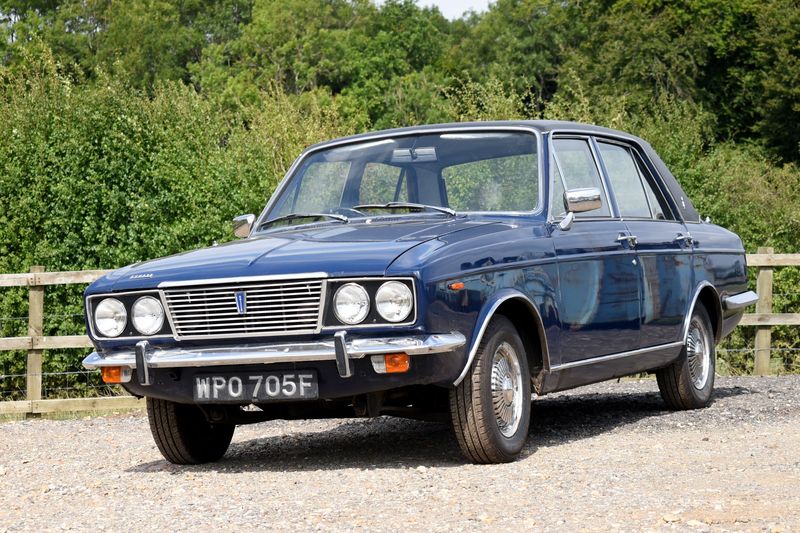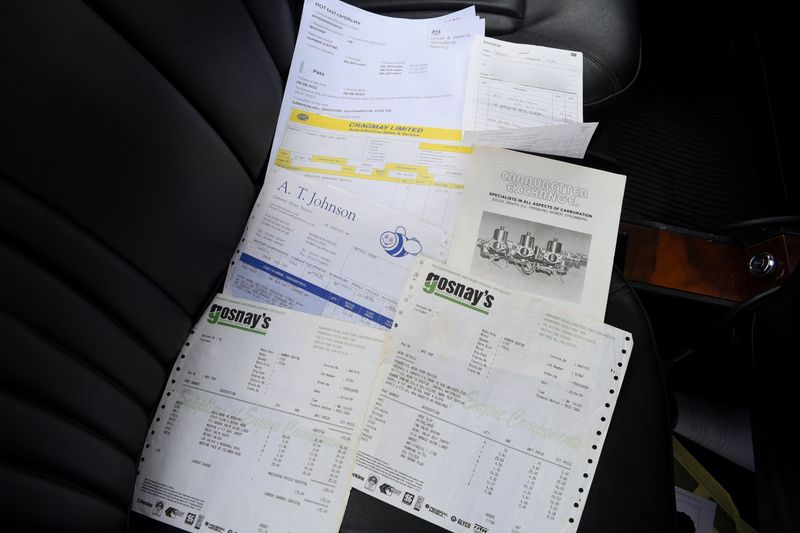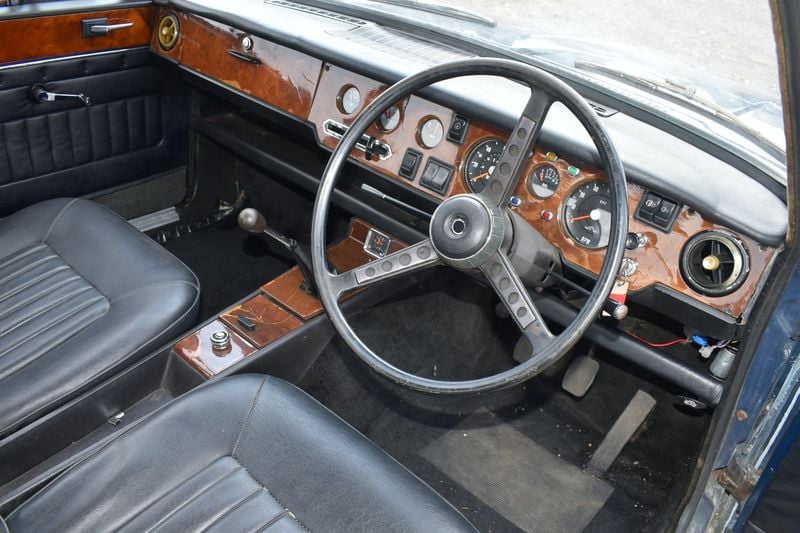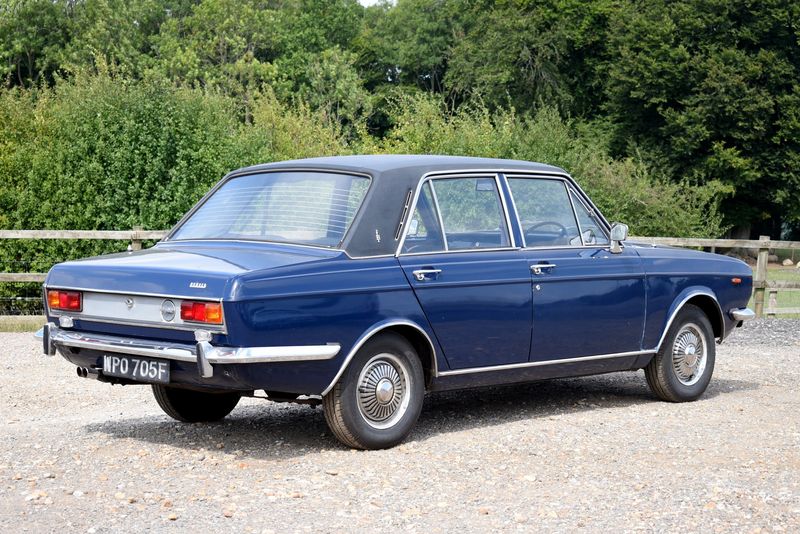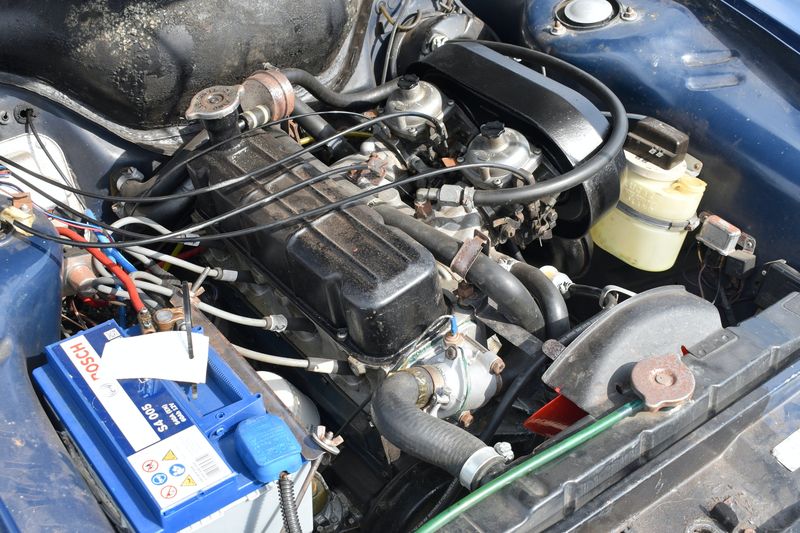Highlights
- Rare and original survivor of Humber’s swansong model
- Typically luxurious, with walnut veneer trim, full instrumentation and vinyl roof
- May be enjoyed as is, or further improved as a straightforward rolling project
- MoT with no advisories valid until 8th August 2023
The Appeal
One of the oldest names in British motoring, having built its first car in 1896, Humber of Coventry soon became one of its most prestigious names as well. By the 1930s, Humbers were made very much for the affluent middle-classes, for bankers and businessmen, statesmen and dignitaries, and even members of the royal family. To own a Humber was to wear a badge of distinction.
It had been owned by the Rootes Group since 1931 and, like much of the British motor industry, Rootes was affected by industrial troubles in the late 1960s, but Humber was always able to hold its head high. In 1966, almost all Rootes models were consolidated onto a single platform, called the Arrow. The entry-level cars were Hillmans, the mid-market ones Singers and the sporty ones Sunbeams, while the luxury ‘junior executive’ model was the Humber Sceptre.
The styling of the Arrows was boxy but very sharp, and the Sceptre was dressed-up very prettily with a more traditional-looking chrome grille and extra chrome trim, and its black vinyl roof afforded a particular air of dignity. The inside had a sober and comfortable appearance, with vinyl seats accompanied by a rich walnut veneer dash and every instrument one could need, including a rev counter, ammeter and oil pressure gauge.
Under the bonnet, it benefitted from the flagship engine of the Arrow range, a 1725cc four-cylinder with alloy cylinder head and twin Stromberg carburettors, producing 88bhp and capable of pushing the car to a highly respectable 98mph. Naturally, being the highest-priced model, it was sold in relatively low volume; only 43,951 Arrow Sceptres were made, so it has always been a fairly uncommon sight.
This very early example is attractively finished in Prussian Blue and presents extremely well. It runs very nicely and is ready to use, show and enjoy just as it is, although there is some scope for improvement if you so desire. A car like this could be treated as a rolling project while also functioning as a daily driver; it has great potential either way.
The History and Paperwork
- First registered in West Sussex in April 1968
- Ownership history traceable to a Miss Julie Webb of Dagenham in 1997
- Acquired by the most recent registered keeper in 2012
- Now in the hands of a classic Rootes specialist, it has received some attention, including a new floor section, to make it fully roadworthy
- Paperwork includes the most recent V5, the current MoT certificate, several invoices from Miss Webb’s ownership dating from 1997 to 2006, some technical diagrams and a large collection of historic MoT certificates from the 1990s and 2000s
The Interior
- Appears to be all original and correct to factory specification
- Luxuriously appointed in true Humber fashion
- Good all-round condition with some patina in places
To step inside this Sceptre is to enter a world of luxury and old-fashioned dignity fully in keeping with Humber tradition. It may use vinyl rather than leather, but it hardly loses points for that when the seats, trimmed in stretching Ambla, are as comfortable as they are, especially the rear seat, which benefits from a folding armrest. It’s a particularly durable vinyl which has obtained no signs of damage that we could see, and scarcely shows its age at all. Better still, the front seats are fully reclining. The doors are every bit as good as the seats.
The generous application of walnut veneer to the dash, door cappings and centre console reminds us that we are in the Rootes Group’s luxury flagship. Although the veneer does show its age a little more than the rest of the interior, with some delamination visible, it is fundamentally sound and all the switches and gauges on the dash are in good condition. The centre console contains some ashtrays and a centrally-positioned clock.
The carpets and headlining are in good condition, with just some light marks around the perimeter of the headlining.
The boot is very clean inside, and it contains a spare wheel in good condition.
The Exterior
- Finished in a rare early colour, Prussian Blue
- Vinyl roof a special feature of the Arrow Sceptre
- Good general condition with some scope for minor improvements
It’s remarkable, really, but the deep, regal colour of Prussian Blue in which this Sceptre is painted was only offered for 1967 and 1968, despite it being one of the nicest colours for the model. Still, there’s no accounting for taste, and the fact that this colour was short-lived makes it that much rarer and more unusual. The black vinyl roof complements it beautifully, and is in very good condition with no evidence of the vinyl lifting that we could see.
The paint itself is mostly very good, though it has some defects, such as scratches, chips and cracks, in a few places. Generally speaking, such defects are extremely minor, though we did observe one or two areas where the ingress of moisture has affected the metal underneath. There are some instances of bubbling underneath the paint, and the offside front wing, driver’s door, nearside sill and rear valence are areas which may require attention in the future.
The wheels are in good condition and, apart from a little bit of light wear and patina, so are the wheel trims. We can’t help remarking, doesn’t the roulette-wheel look of the wheel trims mark them out as one of the most attractive wheel designs of the 1960s?
Despite a little bit of scruffiness here and there, we believe the Sceptre to be a very solid vehicle, especially as the vendor welded a new left hand front outrigger to tidy up and make good a previous repair.
The Mechanics
- A strong engine ideal for everyday use
- Starts, runs and drives very nicely
- Manual gearbox with overdrive
- MoT with no advisories valid until August 2023
Although Rootes cars might have been treated as ordinary family cars when new, enthusiasts today praise them for the durability of their engineering. ‘Bulletproof’ is a word that tends to crop up frequently, and a number of 1960s Rootes cars are still in use as daily-drivers.
The basic 1.6-litre engine used in the cheaper Rootes cars at the beginning of the decade is a strong motor and more than capable of keeping up with modern traffic, so we think the 1725 with twin Strombergs (unique to the Sceptre) must be even better still. Certainly, it started, ran and drove well at our photoshoot. The steering is beautifully light and the brakes work efficiently. It moves in and out of the gears very nicely, and we’re only sorry we didn’t get to go for a proper run in it to experience the as-standard overdrive.
We do not know what mechanical work may have been completed in recent years, but from the invoices we know that the cylinder head received some welding in 1999 and was converted to run on unleaded. At the same time, the valve seats were recut and the valves refaced. The Humber’s mileage then was around 25,500 miles.
It has seen intermittent use since then and has just been issued with a fresh MoT with no advisories, so it should be ready to use and enjoy straight away.
Since the vendor is a specialist Rootes restorer, we have every confidence that all the work he has performed on this car is to the highest standard. Even so, he invites people to visit him and inspect the car in person should they have any doubts.
The Summary
The last ever Humber may have been smaller in size than the Super Snipe and Hawk, which disappeared as it was introduced, but it was very much their successor in terms of quality. While Humber had historically been rival to Jaguar and Rover, the Sceptre was just as comfortably appointed as their contemporary offerings but, if anything, the Sceptre’s smaller size made it easier to live with and more economical.
This car is a very attractive early survivor, blessed with an original interior and a rare, two-year-only colour. Appearing to be in good health mechanically, it could be ideal for anyone looking for a rare and luxurious classic to use as a daily-driver (The Autocar recommended it in particular as a ‘town carriage’ for the ‘young executive’). At the same time, it may require some cosmetic and bodywork attention in the future, but nothing too extensive, so it could be treated as a usable rolling project.
Notice to bidders
All items in this listing are sold on an “As Is - Where Is” basis. Photos and listing descriptions should be used as a guide only. Although every effort has been made to verify the accuracy of the information in this listing and Car & Classic performs a level of due diligence prior to the auction, we do not warrant the accuracy of the listings. The seller assumes all responsibility for this listing. Inspection is highly recommended prior to bidding. Viewings are at the seller’s discretion.
Please take care when making a bid as once your bid is placed, it cannot be withdrawn and will not be cancelled. If you are unsure do not bid as no refunds will be given.
A nonrefundable buyer deposit is applied to all items won at auction. Please see our FAQs and T&Cs for further details.
All bidding is subject to our T&Cs. By registering and bidding you agree to the terms. Please ensure you clearly read them alongside the special terms and conditions contained in this listing.

